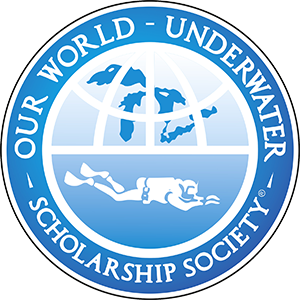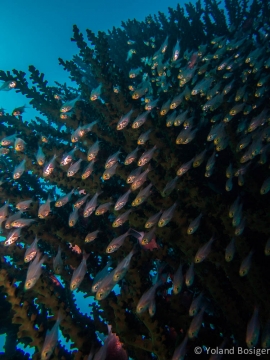I was hanging motionless in the water; my hands gripped my Olympus camera housing waiting for the perfect opportunity to shoot an incredibly beautiful and inquisitive Maori Wrasse. I line up the shot, check my aperture and shutter speed, and adjust my strobe. The male Maori Wrasse swam closer. “Steady, steady, don’t scare him… and fire.” I was in business.
Underwater photography and videography are incredible tools for raising awareness and understanding of the underwater world. They are mediums that have always fascinated me and I longed to learn more. This year, the Our World Underwater Scholarship gave me the most incredible opportunity I could ever have imagined and that was to increase my understanding of videography and photography. Fast track a couple of months and I was learning from one of the best videographers in the Australasia. Richard Brooks is a world-class filmmaker and an expert at capturing images in Palau. Not only is he the in house camera man for Fish n’ Fins dive shop but he is also the creator of Lightening Strike Productions an amazing stock footage library. Check out his footage at: Lightening Strike Productions.
Every day I learned more from Richard. He taught me about the essence of filmmaking. The importance of having a purpose and knowing the story you wanted to share. How to keep things interesting, and to explore as many camera angles as possible. We hit the water and it was go go go finding my subject, adjusting my white balance, and fine-tuning my buoyancy so as to stay completely neutral in the water. Learning with the Light & Motion Bluefin video camera housing and Light & Motion SOLA Video 1200 lights made the whole process so much more enjoyable. These housings are super intuitive, with a one touch white balance and interchangeable red filter making it so easy to produce high quality results. For more information on my set up see: http://www.uwimaging.com/bluefinf80.html. I think filming is one of activities that I have been surprised by this year. I really love it! Check out the SportDiver website for a new video about my experience learning about underwater videography in Palau.
Photography lessons were also on the cards in Palau and it was time to really get a handle of underwater photography. There was a lot to get your head around, from composition, to correct exposure, and adding flash. However, first off we need to properly assemble my Olympus PEN Lite/ E-PL3, Olympus camera housing and Olympus UFL-2 Flash. Olympus has been generously supporting the Our World Underwater Scholarship for a number of years giving Scholars the remarkable opportunity to expand their underwater photography knowledge and experience. I have really enjoyed working with my Olympus camera so far. The PEN Lite/E-PL3 is the perfect choice for photographers who want the flexibility of shooting manually with interchangeable lenses without having to carry around a large bulky SLR. Also fantastic for Scholars with limited baggage allowances!!
Once we had the camera all set up it was time to learn a bit of theory. One extremely useful activity was going through different photos and discussing how the pictures were taken. I also spent a lot of time reading Michael AW’s acclaimed underwater photography handbooks. Michael AW generously donated three of his authored books to me for my Scholarship year and I was incredibly grateful for all the tips. Thanks so much Michael, your books were an absolute blessing!
One of the most challenging parts of underwater photography for me was co coordinating the my strobe. Up until this year, the strobe was completely foreign to me and I learned quite quickly that it requires a bit of patience and practice. In my case a lot of sitting in front of a subject and bracketing – fortunately Richard was an incredibly obliging model. Everyday I learned something new, from the intensity of strobe to the correct angle for different shots. I tried my best to learn from my mistakes and slowly but surely I noticed some improvement.
Palau provided an incredible host of subjects from manta rays, to schools of grey reef sharks, turtles, crocodile fish, moray eels and not to mention the slightly bizarre (AKA the Richard, turtle, batfish sandwich below). Palau also offers incredible cave and wreak opportunities allowing the chance to expand my photography skills even further. Chandelier Cave was probably one of my favourite dives and I enjoyed the challenge of photographing in low light conditions. Check out some of the pictures of Helmet Wreak and Chandelier Cave below.
On the second last day of diving, Richard and I had an incredible experience at German Channel. We saw a large manta feeding just below the surface and were able to swim with it for at least 15 minutes. I was then able to submit my photos to the Palau Manta ID Palau program where the photos are currently being processed. Lunch at the island then allowed an opportunity to film some of local kids playing. It was Sunday so lots of families had come to the islands on their own boats. The sun was shining, stereo was blaring, and everyone was enjoying themselves.
I want to thank Richard for spending so much of his own time helping me out. The number of hours we must have spent going over equipment, taking equipment apart, adjusting photos and reviewing software in that three week period was mind blowing. Richard, you are definitely one of the most generous people I know. Thank you. I also wanted to say a huge thankyou to Howard Womersley who helped me to put my Light & Motion video camera housing together originally in Sydney. Howard, your help saved me a huge amount of time and effort and I cannot thank you enough for your kindness.
Towards the end of my stay in Palau, I got the opportunity to visit Paul Collins and Patrick Colin at the Coral Reef Research Foundation. This non-profit organisation aims to increase knowledge of coral reefs and other marine environments in order to inform management decisions. Meeting Patrick Colin was a real honour and privilege as he is one of the forefathers of coral reef research and diving technology. How could you not like a guy who works on spawning aggregations of groupers, pioneered research with small submersibles, and has built his own plane? Patrick showed me all around the center including an absolutely amazing room of specimens which were collections for the US National Cancer Institute. This was a completely new area of research for me and I was intrigued to learn more the process of generating new drugs from marine species.
Patrick then showed me his collection of Autonomous Sea Gliders which belong to SCRIPPS institution of Oceanography. These incredible machines are capable of gliding from the surface to a programed depth of up to one kilometer and back. Gliders are designed to remain at sea for many months and measure depth, temperature, salinity and chlorophyll along a sawtooth trajectory in the water. Information is then transmitted via wireless telemetry.
Sharon Patris and Gerda Ucharm are marine scientists studying jellyfish at the Coral Reef Research Foundation in Palau. Sharon and Gerda were nice enough to tell me about their work at the Coral Reef Research Foundation which involves measuring water quality characteristics of the jellyfish lakes such as temperature, PH, and salinity over time. How these physical characteristics correlate with jellyfish abundance and health will allow us to better predict the impact of these variables on jellyfish populations in future. I also learned a couple of interesting facts, one being that there are over fifty marine lakes in Palau with at least five containing golden jellyfish. Only one of these lakes is open to the public.
Thanks so much to everyone at the Coral Reef Research Foundation for spending time with me and letting me come and visit.











































Your turning out some really entertaining and informative blogs, looking always forward to the next…
– Bravo Yolly